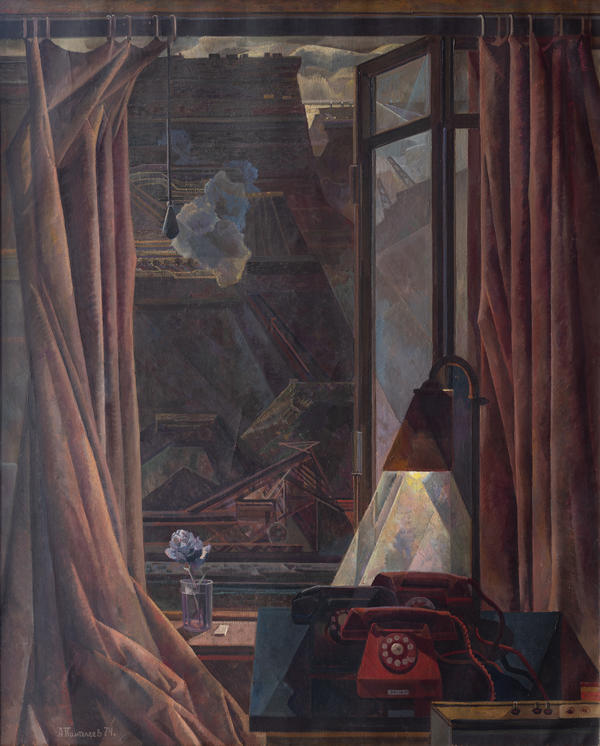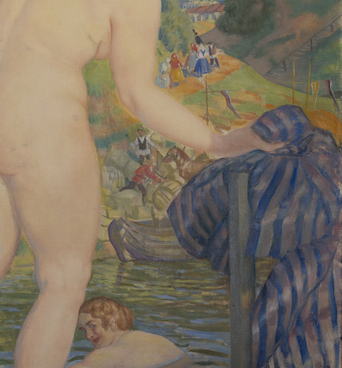The sixties of the 20th century were a period of great humanity achievements. Among them are the beginning of the space age, construction of new railroads, establishment of industrial enterprises, new oil and gas deposits developments. The main idea of the Soviet Art of that period was labour for the sake of the home country and the whole humankind.
This trend of the 60s’ realistic soviet art is called “the austere style”. The artists of this trend depicted “the heroics of the everyday labour”, the energy and the strong will of their contemporaries establishing a powerful state after the war. The main idea of the “austere style” is labour that is taken as a man’s calling. The pictures are always generalized and laconic. Large planes painted in saturated dark colors and hard linear outlines are used to emphasize the expression.
Alexandr Vasilievich Panteleev is a well-known landscape painter. He often chose industrial ‘man-made’ landscapes for his paintings and the compositional constructions of his works all look fully completed and well-thought.
At Red Phones one can see the interior of the room, the still-life painting and the landscape showing the huge blast furnaces behind the window, and all these elements are closely integrated with each other. There are no humans depicted but human presence still can be felt.
The composition of this picture is rather close to the cinematography of that period. The industrial landscapes of Alexandr Panteleev reflect the main stages of the industrial trend development in the Soviet Art.
The outstanding talents and role of Panteleev among the soviet industrial landscape artists of 1970-80s were significant, his works were shown at many exhibitions of that period. The painter was recognized not only by his talented colleagues who had congenial tastes and were evolving at the same time with him, he also had influence on the artists of the younger generation.
In 1976 Panteleev moved to Ufa where he joined the Cherepovets industrial artists’ group and soon became its leader. The painter succeeded to create an original figurative and meaningful composition of the industrial landscape that was his own distinctive style. Depicting the duality of technological progress he tried to express two different patterns of science and technology achievements’ perception — from admiration to full denial.
This trend of the 60s’ realistic soviet art is called “the austere style”. The artists of this trend depicted “the heroics of the everyday labour”, the energy and the strong will of their contemporaries establishing a powerful state after the war. The main idea of the “austere style” is labour that is taken as a man’s calling. The pictures are always generalized and laconic. Large planes painted in saturated dark colors and hard linear outlines are used to emphasize the expression.
Alexandr Vasilievich Panteleev is a well-known landscape painter. He often chose industrial ‘man-made’ landscapes for his paintings and the compositional constructions of his works all look fully completed and well-thought.
At Red Phones one can see the interior of the room, the still-life painting and the landscape showing the huge blast furnaces behind the window, and all these elements are closely integrated with each other. There are no humans depicted but human presence still can be felt.
The composition of this picture is rather close to the cinematography of that period. The industrial landscapes of Alexandr Panteleev reflect the main stages of the industrial trend development in the Soviet Art.
The outstanding talents and role of Panteleev among the soviet industrial landscape artists of 1970-80s were significant, his works were shown at many exhibitions of that period. The painter was recognized not only by his talented colleagues who had congenial tastes and were evolving at the same time with him, he also had influence on the artists of the younger generation.
In 1976 Panteleev moved to Ufa where he joined the Cherepovets industrial artists’ group and soon became its leader. The painter succeeded to create an original figurative and meaningful composition of the industrial landscape that was his own distinctive style. Depicting the duality of technological progress he tried to express two different patterns of science and technology achievements’ perception — from admiration to full denial.




